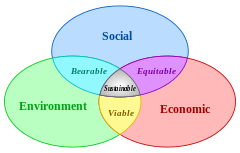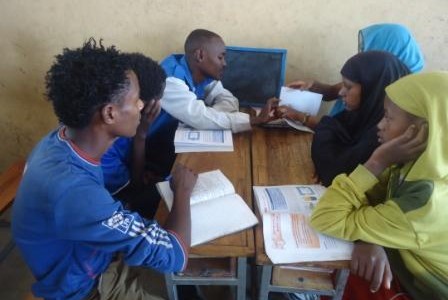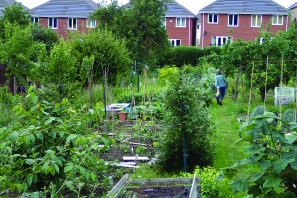The Global Citizenship activities detailed below were carried out by a Working Group at a College of Teacher Education in Ethiopia, with secondary age pupils between 11 and 18. You can download the full project report including visual aids and comparison data in the ‘attachments’.
Below is a brief summary of the activities undertaken:
Sustainability and Sustainable choice
While most people consider quality and cost when buying food, many ignore the impact of their choice on the environment. As we should all be concerned for the environment, and understand the links between the concepts of Sustainability and Social Justice, we decided to incorporate the Sustainable Choice topic into the second year course, Civic and Ethical Education.
We decided to focus on our roles as global consumers and the concept of sustainable choice: buying goods that are produced with sustainable, humane, and healthy practices. We wanted to shed light on the practices of some large companies that have relied on cheap land and labour to produce cheap products and huge profits to the detriment of the environment. We would also explore Fair Trade as a system that ensures that people throughout the supply chain receive fair wages, are treated with dignity, and take steps to respect the environment. Ethical consumption involves recognising the benefits of purchasing products that are organic, locally-sourced, fairly traded, and/or eco-packaged from producers trying to lower their carbon footprint.
Initial audit activities
Several activities were undertaken with secondary age students. An introductory activity asked students to gauge their own impact on environmental sustainability with regard to various activities relating to daily life – for example saving water; reducing pollution; and using recycled materials, – and to indicate the relative importance of these.
They then had to select which of three diagrams best represented the relationship between sustainable development and environmental sustainability.
They also read an 850-word text on the topic, annotating its margins in the following way:
✓for information they already knew
+ for new information;
– for contradictions to what they knew;
? for information that confused them or about which they wanted to know more.
We did a comparison activity aimed to gauge student understanding of environmental sustainability. We were interested in finding out whether the students understood that the most talked about actions in schools e.g. turning taps off and re-using plastic bags although important, have a far lower environmental impact than not eating meat and reducing consumerism. We were also interested to see whether they link the concept of sustainability to social justice.
Students were shown six pairs of photographs representing saving water vs growing one’s own food, and eating less meat vs reusing carrier bags. Working individually, each pair then had to select which of the activities depicted was more important for environmental sustainability, and justify their choice.
Initially, participants prioritized less effective measures, without considering factors such as products being fresh or grown locally with care for land, workers and animals. As an example, 35 (83%) of the participants chose saving water as a more sustainable choice, explaining that tap water should be locked properly and the water should be used sparingly.
In fact, such actions have a less positive environmental impact than growing one’s own food. We have to use water to produce our own food, but growing our own food helps to conserve the soil and produce organic food free from pesticides.
Similarly, 78% of participants initially thought that reusing carrier bags was more important for sustainability than eating less meat. They felt that using carrier bags repeatedly was a more effective measure to ensure sustainability, and that this saved money and ensured customers used them properly.
Actually, eating less meat means less beef demand, which reduces the number of cattle raised. Fewer cattle being raised causes less damage to the environment and this maintains environmental sustainability.
Once the results of this activity were analysed, lessons on sustainable development and environmental sustainability were devised and delivered.
Activities in between
Methods of Teaching: Brainstorming, Pyramiding, and Picture analysis
These activities aimed to: define development and sustainability; compare sustainability to social justice; define the interdependence of environmental sustainability, sustainable development, sustainable choice and Fair Trade, and to identify students’ impact on sustainability and the choices they can make.
Each of these topics was explored and diagrams such as these discussed:
The audit activities were then repeated, and the attitudinal changes identified. Here are the results of one of the comparative activities:
Comparison of the initial and final audit (Which is a more sustainable choice?)
| Pictures compared | Pictures chosen | No. of respondents
(Out of 42 participants) |
|
|
Initial audit |
Final audit | ||
| Saving water vs growing their own food | Saving water | 83% | 38% |
| Growing their own food | 17% | 62% | |
| Eating less meat vs Reusing carrier bags | Eating less meat | 21.4% | 62% |
| Reusing carrier bags | 78.6
|
38% | |
| Beef from protected forest vs deforested forest | Beef from environmentally friendly farming | 66.7% | 95% |
| Beef farmed by clearing forests | 33.3 | 5% | |
|
Buy less new stuff vs recycle more |
Buy less new stuff | 50% | 67% |
| Recycle more | 50% | 33% | |
| Conventional vs fair- trade | Conventional trade | 100% | 0% |
| Fair-trade | 0% | 100% | |
| Free-range eggs vs eggs from caged hens | Free-range eggs | 52% | 100% |
| Eggs from caged hens | 48% | 0% | |
Sample student responses:
Saving water vs Growing one’s own food
“Since food is the basic human need, growing our own food is more important.”
“We should not save water at the expense of growing food. We have to use water to produce our own food. Growing our food helps to conserve the soil.”
We get water naturally from ground and rain, but we cannot get food this way. We have to grow our own food and we have to use water to grow our own food.”
“Growing our own food helps to get organic food free from pesticides. “
Reusing Carrier Bags vs Eating Less Meat:
“When limited amount of meat is eaten meat production lessens.”
“Less cattle raising causes less damage to the environment; this maintains environmental sustainability.”
“People focusing on plants causes less meat demand.”
Furthermore, in the initial audit only 29 participants (69.04%) asserted that there is a circular relationship between sustainable development and environmental sustainability. In the final audit the number of participants maintaining this view increased to 41 (97.6%) of all the participants.
Overall, after the intervention, the majority of the participants clearly understood that environmental sustainability and sustainable development are inseparable realities: sustainable development continuously impacts environmental sustainability and vice versa.




